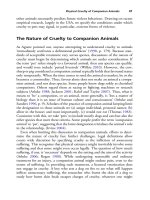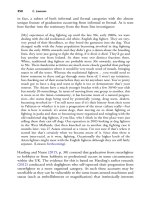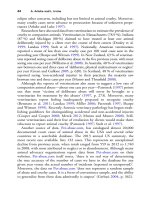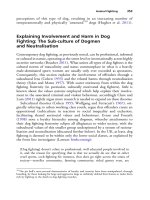The palgrave international handbook of a 187
Bạn đang xem bản rút gọn của tài liệu. Xem và tải ngay bản đầy đủ của tài liệu tại đây (36.15 KB, 1 trang )
180
N. Taylor and H. Fraser
Uncovering how this normativity is expressed and embedded is crucial to
understanding and countering institutionalised animal abuse.
This chapter explores condoned animal abuse in and beyond the slaughterhouse. We begin with the argument that cultural beliefs towards meat are
tied to attitudes towards animals. After all, one cannot have meat without
first killing an animal. From there we seek to assess the ways in which the
killing of nonhuman animals for meat becomes normalised through various
institutional and cultural practices which, in large part through the operation
of the Animal Industrial Complex (AIC), work to maintain the cultural
invisibility of animal killing for food. We focus on the most common form of
research done within slaughterhouses—ethnographic research. We argue that
one finding common to much of this research is the constant and consistent
separation of humans and animals into discrete categories. This ‘purification’
of categories occurs at a symbolic level by ensuring animals are considered as
objects instead of subjects.
Through an analysis of the mechanisms whereby animal slaughter and
death are normalised, this chapter addresses the ways in which the cultural
hegemony of meat and the normalisation of institutional animal abuse are
interconnected and can meaningfully be challenged. We do this by considering the prevalence and nature of violence done in slaughterhouses, followed
by a discussion of explanations for the acceptance and normalisation of such
violence. We conclude with a consideration of how we might respond to
such violence.
Prevalence
Condoned violence is violence that is commonly accepted, overlooked,
ignored, dismissed, trivialised and/or minimised. Systemic violence is violence that is organised, institutionalised and/or embedded in social systems.
In slaughterhouses animals are butchered for food, providing a good example
of both systemic and condoned violence.
Increasing Slaughterhouse Violence
The number of animals killed for slaughter is staggering. It is so large that it
is virtually incomprehensible. According to the Animal Kill Counter
(AKC), more than 150 billion animals are slaughtered each year across
the world. The AKC counts from a composite of industry and popular
media sites. Original data used came from the Food and Agriculture









